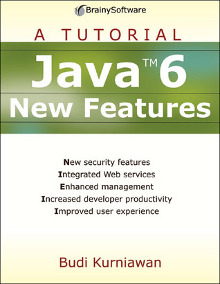 It has been two years since Java 6 was released, so it's really high time to get to know it better.
It has been two years since Java 6 was released, so it's really high time to get to know it better.Book about new features
Earlier this year I read Java 6 New Features by Budi Kurniawan to get an idea of the new features. I liked the book a lot because it is really unique. All the other books you find for Java 6 are general Java books that more or less cover the new features of Mustang. I do not want to read about the methods of
java.lang.Object or the Collections Framework again. Budi Kurniawan does an excellent job focusing only on the new stuff. If you want to know what is new in release 6, go for this book!List of all new classes in Mustang
Then I updated my list of all classes included in the runtime of Java, similar to what I did two years ago. I used Sun's Java 1.6.0_11 and created the updated list of all runtime environment classes in Java 1.6. Let's see what I found: Java 6 added only 74 new types in the
java. name-space,java.awt.Desktop java.awt.font.LayoutPath java.awt.geom.Path2D java.awt.GridBagLayoutInfo java.awt.LinearGradientPaint java.awt.MultipleGradientPaint java.awt.RadialGradientPaint java.awt.SplashScreen java.awt.SystemTray java.awt.TrayIcon java.beans.ConstructorProperties java.io.Console java.io.IOError java.lang.management.LockInfo java.lang.management.MonitorInfo java.net.CookieManager java.net.CookiePolicy java.net.CookieStore java.net.HttpCookie java.net.IDN java.net.InterfaceAddress java.security.PolicySpi java.security.URIParameter java.sql.ClientInfoStatus java.sql.NClob java.sql.RowId java.sql.RowIdLifetime java.sql.SQLClientInfoException java.sql.SQLDataException java.sql.SQLFeatureNotSupportedException java.sql.SQLIntegrityConstraintViolationException java.sql.SQLInvalidAuthorizationSpecException java.sql.SQLNonTransientConnectionException java.sql.SQLNonTransientException java.sql.SQLRecoverableException java.sql.SQLSyntaxErrorException java.sql.SQLTimeoutException java.sql.SQLTransactionRollbackException java.sql.SQLTransientConnectionException java.sql.SQLTransientException java.sql.SQLXML java.sql.Wrapper java.text.Normalizer java.text.spi.BreakIteratorProvider java.text.spi.CollatorProvider java.text.spi.DateFormatProvider java.text.spi.DateFormatSymbolsProvider java.text.spi.DecimalFormatSymbolsProvider java.text.spi.NumberFormatProvider java.util.ArrayDeque java.util.concurrent.BlockingDeque java.util.concurrent.ConcurrentNavigableMap java.util.concurrent.ConcurrentSkipListMap java.util.concurrent.ConcurrentSkipListSet java.util.concurrent.LinkedBlockingDeque java.util.concurrent.locks.AbstractOwnableSynchronizer java.util.concurrent.locks.AbstractQueuedLongSynchronizer java.util.concurrent.RunnableFuture java.util.concurrent.RunnableScheduledFuture java.util.Deque java.util.NavigableMap java.util.NavigableSet java.util.ServiceConfigurationError java.util.ServiceLoader java.util.spi.CurrencyNameProvider java.util.spi.LocaleNameProvider java.util.spi.LocaleServiceProvider java.util.spi.TimeZoneNameProvider java.util.zip.DeflaterInputStream java.util.zip.InflaterOutputStream java.util.zip.ZipErrorand around 400 in
javax. packages,javax.activation javax.annotation javax.jws javax.lang.model javax.script javax.smartcardio javax.tools javax.xml.bind javax.xml.crypto javax.xml.soap javax.xml.stream javax.xml.transform.stax javax.xml.wsmainly the Java Activation Framework, some extended annotations and the model of the Java language. Further there are the new Scripting (JSR 223) and Compiler (JSR 199) APIs. More than half of the new classes are XML related, including XML Binding/JAXB 2.0 (JSR 222), XML signatures (JSR 105), Streaming API 4 XML/StaX (JSR 175) and XML based Web Services/JAX-WS 2.0 (JSR 224).
The need for a better tool
Till now I used some ugly shell scripts to extract the needed information about the classes in
rt.jar. With the growth of the JRE the repeated call of javap -public %class% for each class took more and more time. I needed something else to determine the accessibility of each class. I remembered that there was a field that determined various attributes of a class. I wanted to load the class file's bytes, jump to the offset of this field and read the package/public flag. The Java class file format is simple, but unfortunately not that simple. In order to read the access_flags, one needs to understand the whole constant pool because the access flag is stored afterwards and the constant pool is of variable length. So I started disassembling the class files. I do not know why, but I happened to write the new script in Ruby:
# Unpack HI-LO byte orders contained in the String.
class String
# Return the _index_ 'th and the next element as unsigned word.
def u2(index)
self[index..index+1].unpack('n')[0]
end
end
class JavaClassHeader
# Parse the binary _data_ from the class file.
def initialize(data)
# u4 magic;
# u2 minor_version;
# u2 major_version;
# u2 constant_pool_count;
# cp_info constant_pool[constant_pool_count-1];
constant_pool_count = data.u2(8)
pos = 10
cnt = 1
while cnt <= constant_pool_count - 1
case data.u1(pos) # cp_info_tag
when 7
pos += 3
when 9
pos += 5
when 10
pos += 5
when 11
pos += 5
when 8
pos += 3
when 3
pos += 5
when 4
pos += 5
when 5
pos += 9
cnt += 1
when 6
pos += 9
cnt += 1
when 12
pos += 5
when 1
length = data.u2(pos+1)
pos += 3 + length
else
raise "const ##{cnt} unknown tag #{data[pos]}"
end
cnt += 1
end
# u2 access_flags;
@access_flags = data.u2(pos)
endAfter (sort of) parsing the class file, the check if a class is public or only package accessible was straight forward to implement.ACC_PUBLIC = 0x0001 # Return +true+ if the class is public. def accessible? (@access_flags & ACC_PUBLIC) != 0 endThis improved performance a lot and I am looking forward to the release of Java 7 to use my new ClassList script again.
(Download the list of all classes in Mustang.)
Update 14 Mar 2009
javaclass-rb Project Initiated
The ClassList script was fun and made me want to play more with class files. Based on the source code above, I created javaclass-rb, a parser and disassembler for Java class files, similar to thejavap command. The initial version reads the class file version and the package/public flag of a class as well as the constant pool. Expect updates soon!














